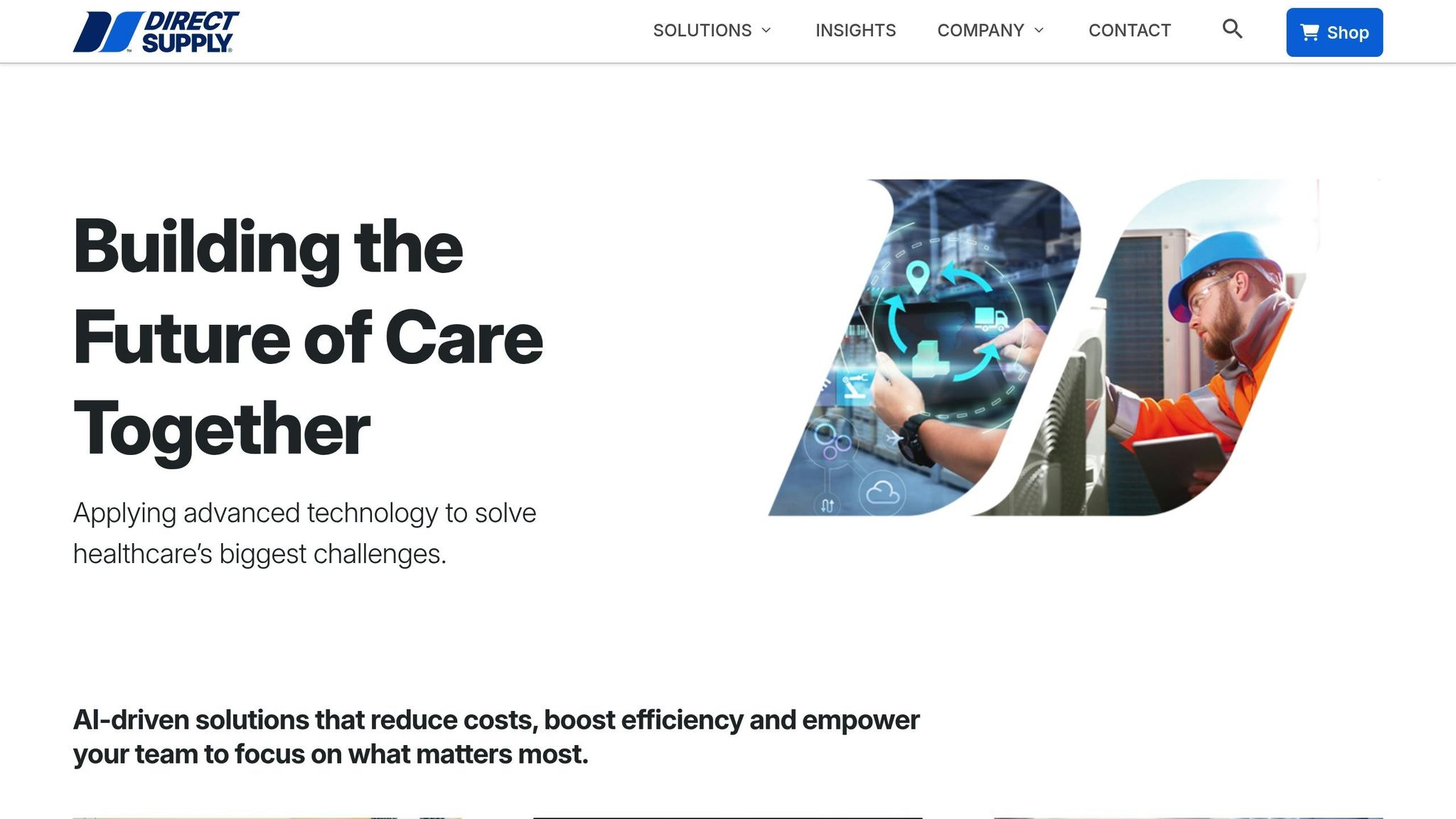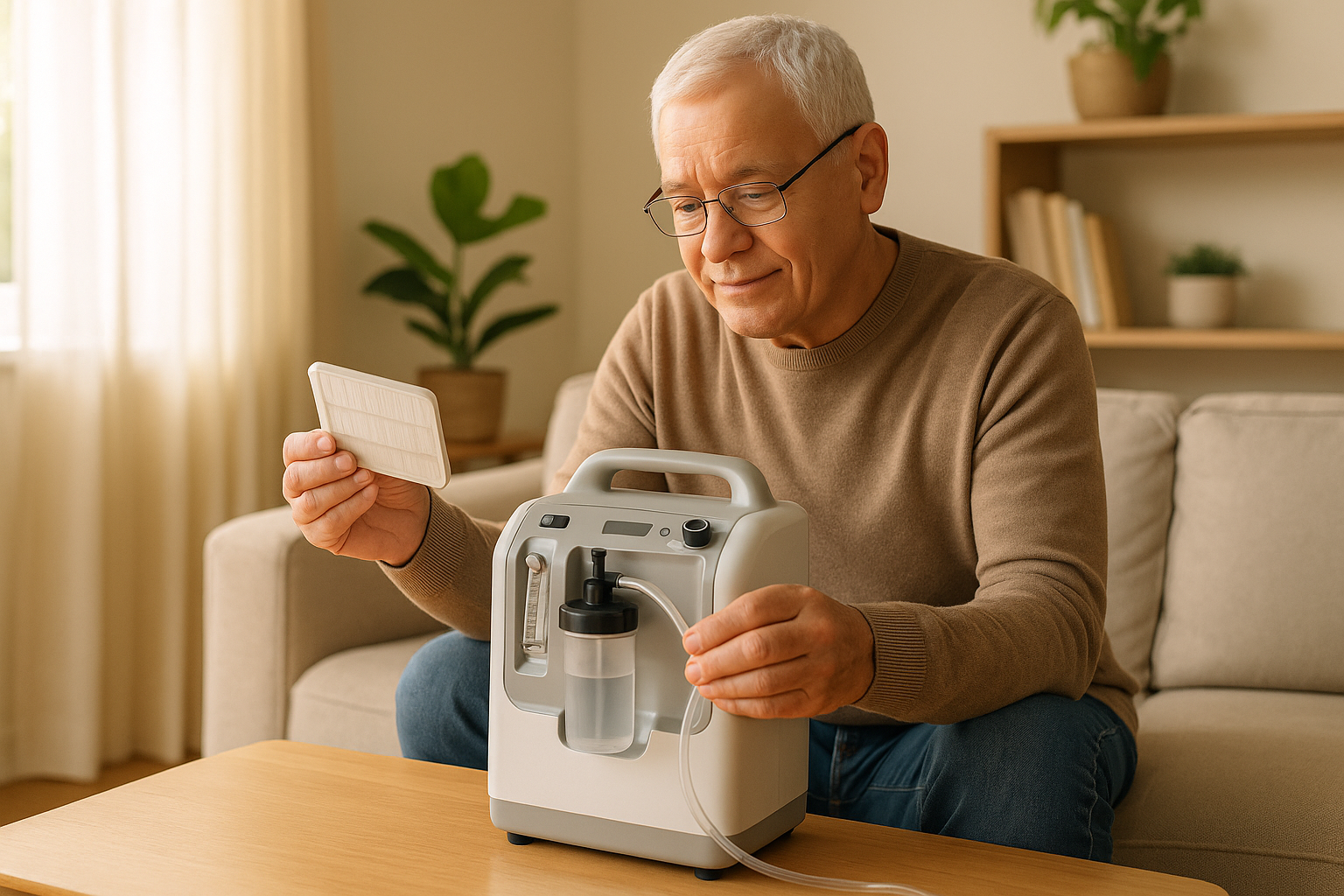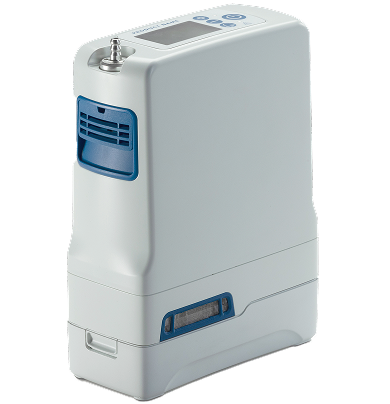Maintaining your oxygen concentrator is essential for ensuring reliable performance, extending its lifespan, and avoiding costly repairs. Regular care helps the device deliver oxygen at the correct purity levels (90%-95%) and prevents health risks caused by reduced output. Here's a quick breakdown of what you need to do:
- Weekly Tasks: Clean the exterior and particle filters, inspect tubing for damage, and ensure proper device placement for ventilation.
- Monthly Tasks: Deep clean the air intake filter, sanitize the humidifier bottle, check power cords, and test digital features.
- Annual Tasks: Schedule professional servicing to inspect internal components, test oxygen output, and calibrate the device.
Direct Supply Presents: Easy Maintenance for Oxygen Concentrators

Weekly Maintenance Tasks
Performing weekly maintenance on your oxygen concentrator is key to keeping it running smoothly and catching potential problems early.
Clean the Outside and Filters
Use a damp cloth to gently clean the exterior of your concentrator. If it's particularly dirty, add a small amount of mild dish detergent, like Dawn™, then rinse thoroughly to avoid leaving residue. Avoid harsh chemicals, as they can damage parts or pose a fire risk.
Remove the particle filter and wash it with warm water and mild dish soap. Rinse thoroughly to remove all soap, then let it air-dry completely before reinserting. It's a good idea to keep a spare filter on hand so you're never without proper filtration. While cleaning, check the filter for any signs of wear, such as rips or fraying, and replace it if needed. Inspect nearby components for damage as well.
"The particle filters must be cleaned weekly to ensure ease of airflow." - ApriaHome Care Team [3]
Check Tubing and Connections
After cleaning, inspect the oxygen tubing and connections. Look for cracks, holes, discoloration, or stiffness. Run your hand along the tubing to check for air leaks and make sure all connections are secure. Watch for kinks or bends that might weaken the tubing over time. If you notice any issues, replace the tubing immediately to ensure proper oxygen delivery.
"Regular inspections of your oxygen concentrator's tubing are as important as the scheduled replacements." - MasVida Health [4]
Check Device Placement
Make sure your concentrator is positioned in a spot that allows proper ventilation and easy access for maintenance. Keep it at least 1–2 feet away from walls or other objects to promote airflow and reduce fire risks. Oxygen can make materials like curtains, bedding, or clothing ignite more easily, so keep the area around the device free of clutter and dust. Also, avoid placing it near heat sources like radiators, heating vents, or windows with direct sunlight.
Monthly Maintenance Tasks
Performing these monthly cleaning and inspection tasks ensures your oxygen concentrator runs efficiently and lasts longer. While weekly care focuses on routine upkeep, monthly tasks delve deeper, addressing areas that require more attention to prevent unnecessary strain on the device.
Air Intake Filter Care
The air intake filter plays a crucial role in trapping dust and debris. To keep it functioning well, remove the filter and wash it with mild soap and warm water. Gently squeeze out any excess water and let it air dry completely before reinstalling.
If the filter remains dirty after cleaning or shows signs of wear, such as deformation or damage, replace it. Manufacturers generally suggest replacing filters every six months, but if you use the device heavily or live in a dusty environment, you may need to do this more often[5]. Ignoring filter maintenance can compromise oxygen purity and overwork the concentrator's motor, potentially leading to early failure[5]. Always use filters designed for your specific model, and ensure the filter is completely dry before putting it back in place - a wet filter can cause damage[6].
Humidifier Bottle Care
Proper humidifier bottle maintenance is essential for device hygiene and your comfort during therapy. Start by emptying any leftover water and rinsing the bottle. Clean it thoroughly with warm, soapy water, focusing on areas prone to mineral buildup, and rinse with hot water to remove any soap residue.
For disinfection, soak the bottle in a mixture of three parts white vinegar to one part water for 20 minutes. This helps dissolve mineral deposits and kills bacteria[1]. Rinse well and let the bottle air dry on a clean surface[7]. If you notice persistent mineral buildup, cracks, or cloudiness, replace the bottle - most manufacturers recommend doing so every three months[7]. Additionally, humidifiers are often suggested when oxygen flow rates exceed 4 liters per minute or if dryness becomes an issue during therapy[8]. Always refill the bottle with distilled water to minimize mineral deposits.
Check Power and Digital Features
Monthly checks of your concentrator's power system and digital functions are vital for identifying potential issues early. Inspect the power cord for cracks, fraying, or exposed wires, and ensure all connections are secure[2]. Keep the area around the concentrator clear and well-ventilated to prevent overheating.
Examine the display panel and status lights. Steady lights typically indicate normal operation, while flashing lights or alarms may point to problems like low oxygen levels or system malfunctions[10]. If your concentrator has an LCD display, review any error codes or status messages and consult the user manual for troubleshooting. Some models include an hour meter to track usage; if this isn’t visible, look for a "reset" or "info" button to toggle through display modes. Double-check that the device isn’t in standby or sleep mode[9].
If you encounter persistent issues, try performing a hard restart by disconnecting the power (and batteries, if applicable), waiting 20 minutes, and reconnecting[2]. For unresolved problems or a blank display, reach out to your equipment provider's customer support team for assistance[9].
sbb-itb-3e96dba
Annual Maintenance and Professional Service
Annual maintenance goes beyond routine care by focusing on internal components and precise calibration using specialized tools. Scheduling a yearly service ensures your oxygen concentrator gets a thorough inspection and necessary adjustments, helping it maintain peak performance year-round.
Schedule Professional Service
When arranging professional maintenance, choose a technician certified by recognized industry organizations. Verify their experience with your specific concentrator brand and model. It's also smart to ask about their availability for scheduled maintenance and emergency repairs. Checking reviews or asking for recommendations can give you a better sense of their reliability and service quality.
Before your appointment, make a note of any unusual noises, error messages, or performance changes since the last service. This information can help the technician quickly pinpoint potential issues. During the visit, expect tasks like internal cleaning, calibration, and replacing filters that you can't service yourself. The technician will also inspect critical components like the compressor and sieve beds and run a full diagnostic to check for electrical or mechanical problems. After the service, ensure your concentrator is running within its optimal performance range.
Test Oxygen Output and Alarms
Regularly testing oxygen purity and alarm systems is essential for safety. Contact your service provider to schedule a test, which may involve a technician visiting your home or you bringing the device to their facility. This is especially important for individuals who depend on consistent oxygen delivery.
During the service, the technician will check all key components, perform routine maintenance, and run performance tests to confirm the concentrator is delivering the correct oxygen concentration and flow rate. Using specialized tools, they’ll measure oxygen purity and ensure the device meets medical standards. They’ll also calibrate the concentrator and test the alarm systems to make sure they activate properly if oxygen levels drop or if there’s another malfunction. If you notice persistent error messages or irregular performance, don’t wait - schedule a professional assessment to restore the device’s functionality.
Update Your Maintenance Records
Keeping detailed maintenance records is a practical way to track your concentrator’s performance and avoid unexpected breakdowns. After every service, log the type of maintenance performed, the date, technician details, parts replaced, and any key observations. These records are invaluable for refining your preventative maintenance schedule and ensuring your device stays in top condition.
Assign responsibility for recordkeeping to yourself, a family member, or a healthcare provider to maintain consistency. Detailed logs not only help with proactive maintenance but also demonstrate a strong commitment to safety and quality care.
Safety Tips and Best Practices
Maintaining your oxygen concentrator goes beyond routine cleaning and inspections. Following these additional safety measures can help protect both your equipment and your well-being. Plus, these tips can extend the life of your concentrator while ensuring it delivers oxygen effectively.
Use Distilled Water in Humidifiers
Always opt for distilled water in your humidifier bottle. Unlike tap water, distilled water is free of minerals, salts, and germs that could harm your equipment. Tap water often contains minerals like calcium, magnesium, and chlorine, which can accumulate inside the humidifier bottle and tubing. Over time, this buildup creates a breeding ground for bacteria and fungi, especially if water sits stagnant. Using distilled water reduces these risks and keeps your oxygen therapy safer.
Replace distilled water daily and clean the humidifier bottle every one to two days with a mild detergent or a vinegar solution. If distilled water isn’t available, sterile or purified water can be used as an alternative. You can also sterilize water at home by boiling it for five minutes and letting it cool completely before use.
Once your humidifier is in check, don’t forget to organize and store your equipment properly.
Store Accessories Properly
Keep spare parts and accessories in a clean, dry, and well-ventilated space, away from direct sunlight and high temperatures. Use labeled, dry containers for storage, and store removable batteries separately in a cool, dry place. Make sure batteries are fully charged before storing them to prevent drainage.
To minimize moisture, consider placing silica gel packets near your storage area. Regularly inspect your accessories for wear and damage during maintenance checks. Avoid storing your concentrator or its parts in enclosed spaces like closets or car trunks, especially in hot weather, as these environments can trap heat and moisture, potentially damaging the equipment.
Keep Away from Heat Sources
Position your concentrator at least 6 feet away from heat sources, such as stoves, heaters, fireplaces, and open flames. Ensure there’s enough space for air to circulate by keeping the device several inches away from walls, curtains, and furniture. Never place items on top of the unit.
It’s critical to avoid smoking or allowing others to smoke near your oxygen equipment. Also, steer clear of aerosol products and petroleum-based items like vapor rubs, petroleum jelly, or oil-based hand lotions, as these are highly flammable in oxygen-rich environments. Posting visible “Oxygen in Use” and “No Smoking” signs near entryways can help alert visitors to potential fire hazards.
If you’re cooking, move at least 5 feet away from the stove before using supplemental oxygen. Keeping your equipment out of the kitchen during meal prep can significantly reduce fire risks.
Maintenance Schedule Summary
Following a structured maintenance schedule can help you spot potential issues early and keep your device running smoothly and reliably [12]. Below is a summary of tasks to perform weekly, monthly, and annually, based on the detailed steps outlined earlier.
To stay on track, consider setting calendar reminders so you never miss a maintenance task [13].
| Frequency | Key Tasks | Time Required |
|---|---|---|
| Weekly | Wipe down the exterior, clean filters, inspect tubing and connections, and confirm proper placement of the device | 15–20 minutes |
| Monthly | Thoroughly clean air intake filters, sanitize the humidifier bottle, and check power and digital features | 30–45 minutes |
| Annually | Arrange professional servicing, test oxygen output and alarms, and update maintenance records | 2–3 hours (including service appointment) |
Keep a log of every maintenance task, including dates and any observations [12]. This record can be incredibly helpful when discussing your equipment with healthcare providers or service technicians.
Your environment and usage habits may require tweaking this schedule. For instance, if you live in a dusty area or operate the device for long hours daily, you might need to clean filters more often. Similarly, homes with pets or exposure to smoke may benefit from more frequent cleaning.
Maintenance checklists are more than just a routine - they help ensure your device operates efficiently, reducing the risk of malfunctions and expensive repairs [11]. Print this schedule or save it to your phone for easy access during your maintenance tasks.
FAQs
You should change the filters in your oxygen concentrator every six months, or follow the timeline recommended by the manufacturer. That said, this can differ based on factors like the amount of dust, pollen, or airborne particles in your surroundings, as well as how often you use the device.
For those in areas with heavy dust or who rely on their concentrator daily for long hours, filter replacements might need to happen more frequently to keep the device running efficiently. Make it a habit to check the filters regularly and clean the device as needed - this will help you spot when it’s time for a replacement.
If your oxygen concentrator isn’t providing the right oxygen purity levels, there are a few things you can check right away. First, make sure the intake vents are clear of any obstructions. Then, clean or replace the filters if needed. Also, inspect the tubing and cannula to ensure they’re securely connected and free from any kinks, blockages, or visible damage. Don’t forget to check the device for warning lights or alerts that might signal an issue with oxygen purity.
If none of these steps fix the problem, it’s time to reach out to a qualified technician or service professional. They can inspect the concentrator and handle any repairs it might need. Routine maintenance is essential to keep your device operating safely and efficiently.
If your oxygen concentrator starts showing unusual noises, a drop in oxygen flow, or displays error messages, it might be time to have it checked by a professional. Other warning signs include cracked or discolored tubing, debris in the filters, or unfamiliar odors coming from the machine.
You should also watch for physical symptoms like headaches, drowsiness, confusion, bluish lips or fingernails, or even increased anxiety. These could signal that the device isn't providing oxygen as it should. If you notice any of these problems, arrange for a professional inspection right away to keep your concentrator functioning properly and safely.




